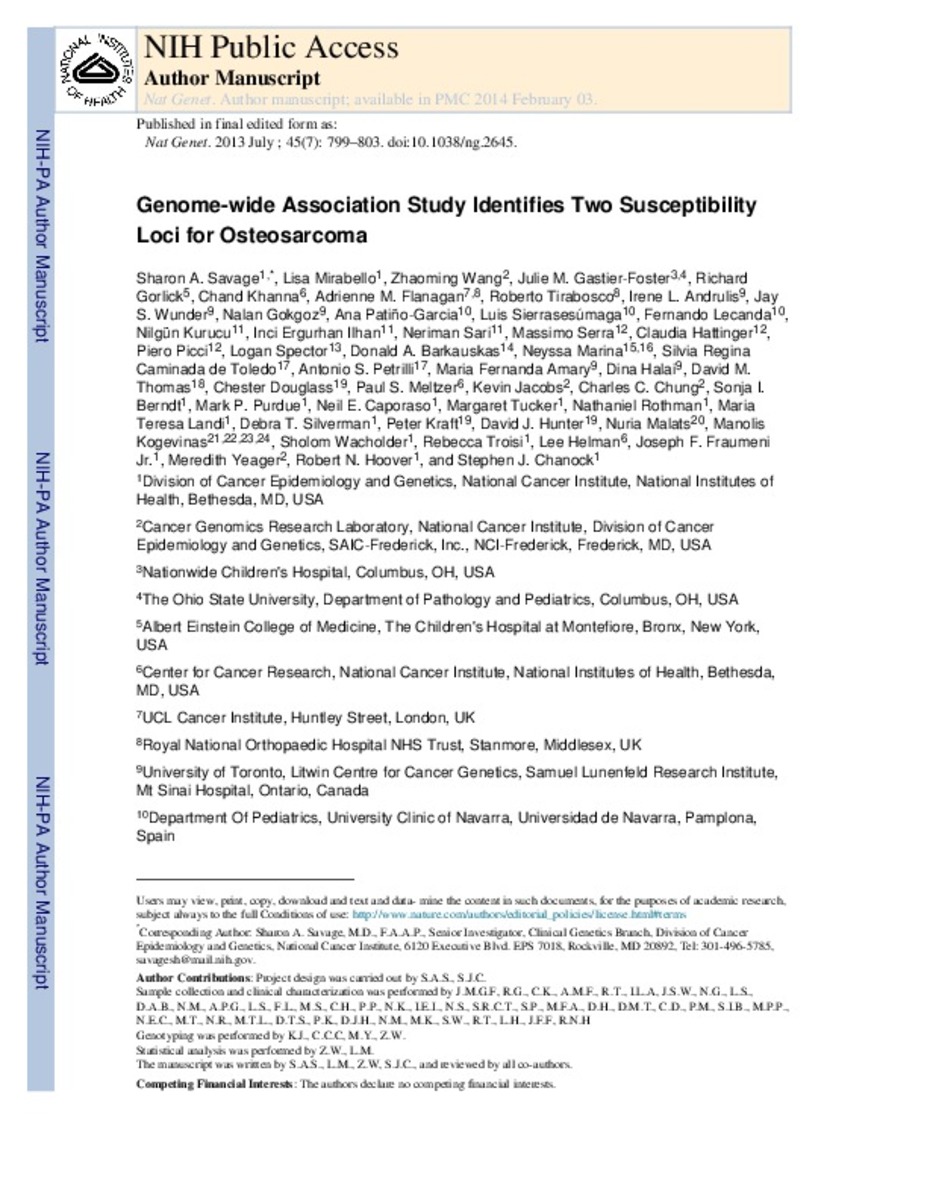Full metadata record
| DC Field | Value | Language |
|---|---|---|
| dc.creator | Savage, S.A. (Sharon A.) | - |
| dc.creator | Mirabello, L. (Lisa) | - |
| dc.creator | Wang, Z. (Zhaoming) | - |
| dc.creator | Gastier-Foster, J.M. (Julie M.) | - |
| dc.creator | Gorlick, R.G. (Richard G.) | - |
| dc.creator | Khanna, C. (Chand) | - |
| dc.creator | Flanagan, A.M. (Adrienne M.) | - |
| dc.creator | Tirabosco, R. (Roberto) | - |
| dc.creator | Andrulis, I.L. (Irene L.) | - |
| dc.creator | Wunder, J.S. (Jay S.) | - |
| dc.creator | Gokgoz, N. (Nalan) | - |
| dc.creator | Patiño-García, A. (Ana) | - |
| dc.creator | Sierrasesumaga, L. (Luis) | - |
| dc.creator | Lecanda, F. (Fernando) | - |
| dc.creator | Kurucu, N. (Nilgün) | - |
| dc.creator | Ilhan, I.E. (Inci Ergurhan) | - |
| dc.creator | Sari, N. (Neriman) | - |
| dc.creator | Serra, M. (Massimo) | - |
| dc.creator | Hattinger, C. (Claudia) | - |
| dc.creator | Picci, P. (Piero) | - |
| dc.creator | Spector, L. (Logan) | - |
| dc.creator | Barkauskas, D.A. (Donald A.) | - |
| dc.creator | Marina, N. (Neyssa) | - |
| dc.creator | Caminada-de-Toledo, S.R. (Silvia Regina) | - |
| dc.creator | Petrilli, A.S. (Antonio S.) | - |
| dc.creator | Amary, M.F. (María Fernanda) | - |
| dc.creator | Halai, D. (Dina) | - |
| dc.creator | Thomas, D.M. (David M.) | - |
| dc.creator | Douglass, C. (Chester) | - |
| dc.creator | Meltzer, P.S. (Paul S.) | - |
| dc.creator | Jacobs, K. (Kevin) | - |
| dc.creator | Chung, C.C. (Charles C.) | - |
| dc.creator | Berndt, S.I. (Sonja I.) | - |
| dc.creator | Purdue, M. (Mark) | - |
| dc.creator | Caporaso, N.E. (Neil E.) | - |
| dc.creator | Tucker, M. (Margaret) | - |
| dc.creator | Rothman, N. (Nathaniel) | - |
| dc.creator | Landi, M.T. (María Teresa) | - |
| dc.creator | Silverman, D.T. (Debra T.) | - |
| dc.creator | Kraft, P. (Peter) | - |
| dc.creator | Hunter, D.J. (David J.) | - |
| dc.creator | Malats, N. (Nuria) | - |
| dc.creator | Kogevinas, M. (Manolis) | - |
| dc.creator | Wacholder, S. (Sholom) | - |
| dc.creator | Troisi, R.J. (Rebecca J.) | - |
| dc.creator | Helman, L. (Lee) | - |
| dc.creator | Fraumeni, J.F. (Joseph F.) | - |
| dc.creator | Yeager, M. (Meredith) | - |
| dc.creator | Hoover, R.N. (Robert N.) | - |
| dc.creator | Chanock, S.J. (Stephen J.) | - |
| dc.date.accessioned | 2014-08-30T17:26:57Z | - |
| dc.date.available | 2014-08-30T17:26:57Z | - |
| dc.date.issued | 2013-07 | - |
| dc.identifier.citation | Savage SA, Mirabello L, Wang Z, Gastier-Foster JM, Gorlick R, Khanna C, et al. Genome-wide association study identifies two susceptibility loci for osteosarcoma. Nat Genet. 2013 Jul;45(7):799-803 | es_ES |
| dc.identifier.issn | 1061-4036 | - |
| dc.identifier.uri | https://hdl.handle.net/10171/36418 | - |
| dc.description.abstract | Osteosarcoma is the most common primary bone malignancy of adolescents and young adults. To better understand the genetic etiology of osteosarcoma, we performed a multistage genome-wide association study consisting of 941 individuals with osteosarcoma (cases) and 3,291 cancer-free adult controls of European ancestry. Two loci achieved genome-wide significance: a locus in the GRM4 gene at 6p21.3 (encoding glutamate receptor metabotropic 4; rs1906953; P = 8.1 × 10⁻⁹) and a locus in the gene desert at 2p25.2 (rs7591996 and rs10208273; P = 1.0 × 10⁻⁸ and 2.9 × 10⁻⁷, respectively). These two loci warrant further exploration to uncover the biological mechanisms underlying susceptibility to osteosarcoma. | es_ES |
| dc.language.iso | eng | es_ES |
| dc.publisher | Nature Publishing Group | es_ES |
| dc.relation | info:eu-repo/grantAgreement/NIH/NATIONAL_CANCER_INSTITUTE/3U10CA098543-03S1/US | - |
| dc.relation | info:eu-repo/grantAgreement/NIH/NATIONAL_CANCER_INSTITUTE/3U24CA114766-05S2/US | - |
| dc.rights | info:eu-repo/semantics/openAccess | es_ES |
| dc.subject | Osteosarcoma | es_ES |
| dc.subject | Polymorphism, single nucleotide | es_ES |
| dc.subject | European continental ancestry group | es_ES |
| dc.subject | Bone neoplasms | es_ES |
| dc.title | Genome-wide association study identifies two susceptibility loci for osteosarcoma | es_ES |
| dc.type | info:eu-repo/semantics/article | es_ES |
| dc.identifier.doi | http://dx.doi.org/10.1038/ng.2645 | es_ES |
Files in This Item:
Statistics and impact
Items in Dadun are protected by copyright, with all rights reserved, unless otherwise indicated.






